#ancient zulu fashion
Explore tagged Tumblr posts
Text
Some Human AU drawings I did for some non human Disney characters
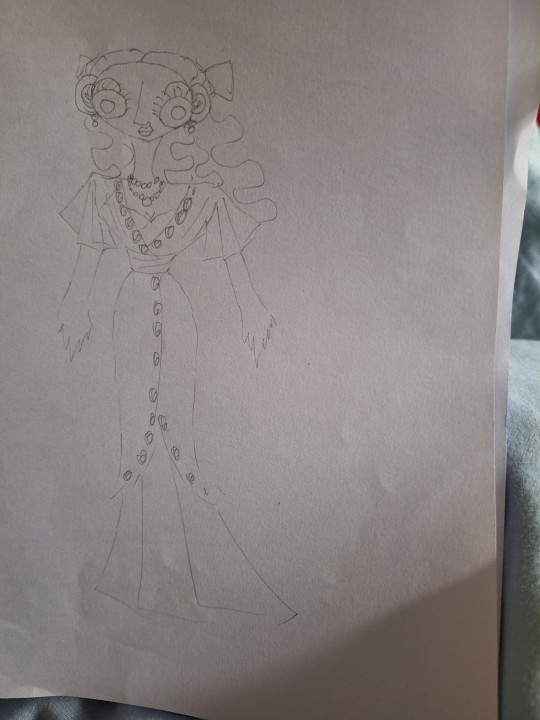
A drawing I did for Lady from Lady and the Tramp in a Human AU
I imagine that, In a Human AU, Lady has dark auburn curls, sun kissed skin and big bright brown eyes
And Judy Garland is a face model of mine for Human AU! Lady
🤩🤩🤩🥺🥺🥺🥺

A drawing I did for Duchess from Aristocats in a Human AU
I imagine that, In a Human AU, Duchess has sunshine blonde curls, fair skin, rosy cheeks and big sapphire blue eyes
And Eva Gabor is a face model of mine for Human AU! Duchess
🤩🤩🤩🥺🥺🥺
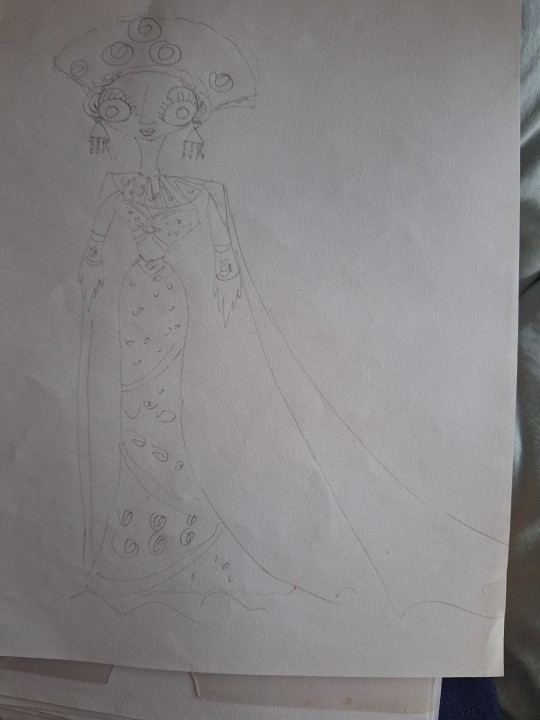
A drawing I did of Queen Nala of Pride Rock in a Lion King Human AU
As a Zulu Queen, Human AU Nala defo be DRIPPING in Ancient Zulu accessories and attires fit for a Queen
I imagine Human AU Nala to be a gorgeous woman with dark brown skin, dark frizzy hair, and also gorgeous jade green eyes
And Queen Nandi of the Zulu and Ramonda are amongst my face models for Human AU Nala
🤩🤩🥺🥺🥺
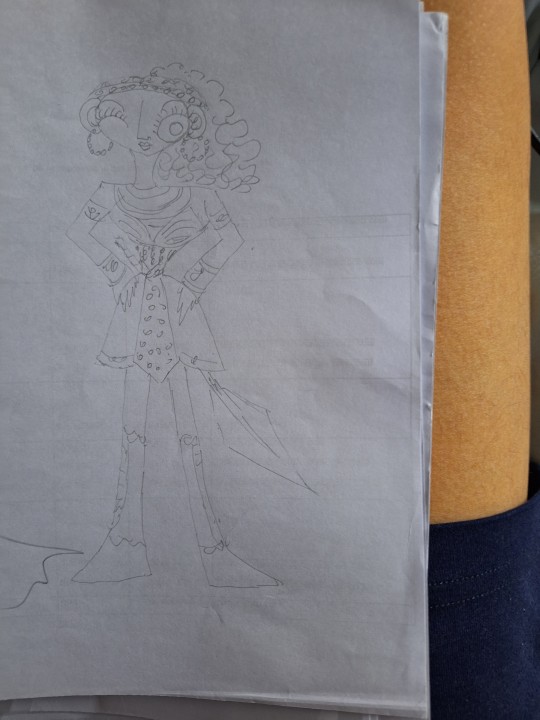
A drawing I did of Human AU! Kiara from Lion King
As opposed to her more proper lady mom, Kiara is kind of more of a shieldmaiden, so I imagine Human AU! Kiara to have her wardrobe with a blend of Zulu shieldmaiden armors and practical yet stylish Zulu robes that allow much movement, and her wardrobe is a mix of zestiness and showing off her regal bearing as a real Zulu Princess
Makeda of Sheba and Shuri are amongst my face models for Human AU! Kiara btw
And I imagine Human AU! Kiara to have chocolate skin, dark brown hair and bright brown eyes
🤩🤩🤩🥺🥺🥺🥺🥺
#human au disney animal characters#ancient zulu fashion#1910s fashion#lady from lady and the tramp#duchess aristocats#queen nala#princess kiara
0 notes
Text
Praise our ancestors for blessing us with the perfect Earthly skin that ABSORBS the SUN & doesn’t melt into our adult age.
& hair that resembles LITERAL HUMAN DNA (DeoxyriboNucleic Acid)


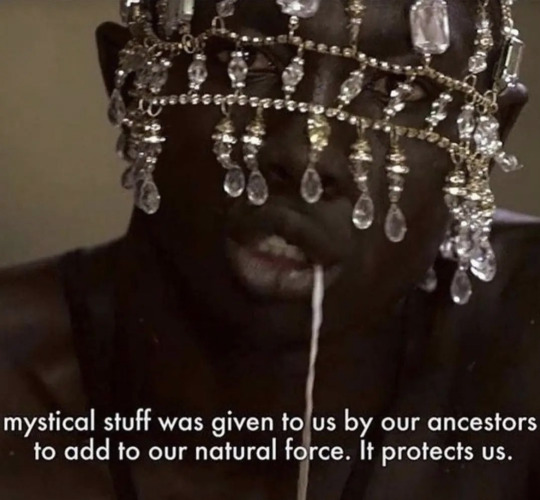
#divine feminine#melanin#kemetic#moors#black girl aesthetic#black girls of tumblr#black culture#black history#black beauty#ancient kemet#ancient egypt#shaka zulu#thoth#osiris#horus#ra#astrology#girl blogger#children of the sun#the sun loves black people#pan africanism#ethiopia#african queen#african culture#nefertiti#beauty#beauty standards#catwalk#high fashion#fashion
3K notes
·
View notes
Note
I have for you a game! Below are 3 badly translated book titles:
"Honey"
"Oz"
"Red Paper"
Write for me their plots, please!
Ooh, this is funky!
"Honey" gives me the vibe of the title being incredibly poetic, but the translation went way too literal and succinct with it. Maybe the original title was something like "The Nectar of Life", and it was a story about the protagonist learning to cope with grief after inheriting their mother's massive garden. It feels like the kind of story that, if someone else wrote it, would have obligatory romance, but if I were the one writing it there wouldn't be romance. Instead, the kinds of love explored would be familial love (obviously), self-love (how do you make life worth living for yourself as well as your dead), and love for the land (the earth may be a cruel thing that buries your dead, but also is a warm living thing that nurtures present and future life).
"Oz" just makes me think of the Wizard of Oz, except all epithets and titles are just cut because they reflect certain concepts that just can't be translated easily into English. Probably a farcical absurdist comedy that uses the fantastical world of Oz as the set to exaggerate and explain a very specific political climate that just never applied to the USA.
For "Red Paper", I'm kinda hooked on the idea of satirizing the old European pulp fics like Indiana Jones and Allan Quatermain that exotified and homogenized African nations. It would be named "Crimson Pulp, Scarlet Parchment" (so, badly translated to "Red Paper Red Paper"), and it would follow a tough but charming Zulu historian's journey across the entire European continent searching for a missing scarlet parchment Tome that held ancient knowledge from 500 years ago, including the location of some good old fashioned treasure in a tomb! Because pulp fiction loves raiding tombs! Along the way, the historian works alongside the sharp and witty love interest with a soft side, and that one token European sidekick guy TM. A very typical plot, action packed but ultimately light-hearted.
This was fun! I'm gonna send you some titles too! Get your own game back :D
6 notes
·
View notes
Text
Over on Tik Tok I talk about books and literature, with book recommendations once a week. So, let’s bring that energy here! Sounds like a time.
My theme for the months of November and December are books I enjoyed reading this year! Today you’ll get a two for one to catch up with BookTok.

The Prey of Gods
Nicky Draeyden
Combo sci-fi fantasy, afro-futurism
from Storygraph
In South Africa, the future looks promising. Personal robots are making life easier for the working class. The government is harnessing renewable energy to provide infrastructure for the poor. And in the bustling coastal town of Port Elizabeth, the economy is booming thanks to the genetic engineering industry which has found a welcome home there. Yes--the days to come are looking very good for South Africans. That is, if they can survive the present challenges: A new hallucinogenic drug sweeping the country . . . An emerging AI uprising . . . And an ancient demigoddess hellbent on regaining her former status by preying on the blood and sweat (but mostly blood) of every human she encounters. It's up to a young Zulu girl powerful enough to destroy her entire township, a queer teen plagued with the ability to control minds, a pop diva with serious daddy issues, and a politician with even more serious mommy issues to band together to ensure there's a future left to worry about.
This book does an excellent job of interleaving multiple different viewpoints into one giant mishmash of story where everything comes together in the end in a spectacular fashion. While some of the threads could have used a little more room to breathe, the way it so expertly combines such vastly different sci-fi and fantasy concepts is extremely cool and not something I see very often. It navigates the concepts of identity through a lens of queerness, generational family trauma, chronic illness, and the implication of genetic divinity.
It’s a wild ride, and immediately endeared me to the author enough to pick up literally every other thing she’s ever written.
2 notes
·
View notes
Text
How vintage is hip-hop?
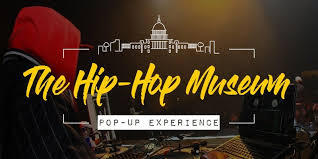
The beginning of hip hop is thought to now lower returned to Aug. Eleven, 1973, wherein DJ Kool Herc, really referred to as Clive Campbell, and his pal hosted a again-to-college birthday party in the Bronx, big apple. Eighteen-12 months-vintage Campbell and his friend Coke los angeles Rock are often referred to as the fathers of hip-hop.
The primary DJ:
History of DJing
In 1935, American radio commentator Walter Winchell coined the time period "disc jockey". In 1943, radio DJ Jimmy Savile launched the sector's first DJ dance celebration by way of playing jazz statistics inside the upstairs function room of the reliable Order of ancient Shepherds in Otley, England.
The four fathers of rap:
Numerous founders say that Kool Herc, Grandmaster Flash, Afrika Bambaataa, and Melle Mel—those normally credited because the creators—will admit they had been stimulated by means of manner of a generation of HipHop that existed in advance than 1973.
The 4 factors of hip-hop:
While there's some debate over the range of things of hip-hop, there are 4 elements that is probably considered to be its pillars: deejaying, or “turntabling”; rapping, also known as “MCing” (emceeing) or “rhyming”; graffiti portray, moreover known as “graf” or “writing”; and break dancing, or “B-boying,” which encompasses.
Fast rap is known as:
Chopper is a hip-hop track subgenre that originated in the Midwestern u.S. Of us and has competencies of rapid-paced rhyming or rapping. Individuals who rap in fashion are known as choppers, and rapping inside style is from time to time known as slicing.
Gradual rap is called:
Mumble rap
Mumble rap is relative to a derogatory time period for some artists. But, in plenty of techniques, it is an honest description of a fantastic rap style it simply is famous proper now.
The 3 styles of hip-hop:
A short manual to the numerous forms of hip-hop. Gangsta. Lure. Cloud Rap.
Gangster rap is known as:
Gangsta rap or gangster rap, to begin with called reality rap, emerged in the mid-to past due Eighties in l. A. Is a debatable hip-hop subgenre whose lyrics assert the life-style and values standard of city American gangs and road hustlers.
South African music is referred to as:
The South African song scene consists of each famous (jive) and folk paperwork like Zulu isicathamiya creating a song and harmonic mbaqanga. Exceptional popular genres are Marabi, Kwaito, house music, Isicathamiya, Gqom, rock song, hip hop and Amapiano.
The Naija music is referred to as:
Famous music genres loved with the aid of Nigerians and now globally embody Jazz, Highlife, Jùjú, Afrobeat, Reggae, and Afrobeats. Fela Kuti became instrumental in the adoption of Jazz and Afrobeat. A current mainstream track referred to as 'Afrobeats' or 'Afropop' takes cues from beyond patterns.
Afro-pop track in South Africa:
Afro-Pop is a seize-all-time period encompassing the wealthy style of modern-day African music patterns -- usually city, electric-powered dance songs.
The tune is first inside the world:
The earliest fragment of musical notation is placed on a 4,000-12 months-vintage Sumerian clay tablet, which incorporates commands and tunings for a hymn honoring the ruler Lipit-Ishtar. However, for the call of the oldest extant tune, most historians factor in “Hurrian Hymn No.
Began African song:
African song modified into first recorded by Egyptian musicians in the third millennium BC. The Egyptians used a massive form of musical gadgets, which encompass harps, flutes, drums, and cymbals.
The biggest song on facts:
For day-by-day wit & records, be part of the Almanac e-newsletter.
The longest recorded pop music is “Apparente Libertà,” by Giancarlo Ferrari, that is seventy-six mins, forty-four seconds long. This passed the preceding report of “The satan Glitch,” by way of using Chris Butler, it really is sixty-9 mins lengthy.”
Ok-pop is famous in South Africa:
South Africa is the top market for good enough pop in Sub-Saharan Africa. The most well-known K-pop artist is BTS, their Coldplay collaboration song My Universe being the maximum streamed okay-pop track on Spotify.
1 note
·
View note
Text
Suki’s Over Analytical TWST Headcanon AU!
So this is not as much of an AU as some might be, but rather an explanation of what I’ve added to the canon to fill in the blanks and color the world as a whole a bit more than what’s shown. These ideas are largely dictated by canon, so as my understanding of the world improves or more information is released, some of this might be changed or just plain made incorrect.
Part 2: Countries and culture
As stated in the previous part, a lot of lands and countries are often classified and described based on the human’s culture that resides there. For ease of understanding I will give examples from our world that most closely resemble the cultures and languages of Wonderland.
UPDATE! Due to the English translation changing names of lands, some of these may not be the same as canon. Also, chapter 6 gave us a world map that...I'm choosing to ignore at this time. This is why my descriptions of "the west/east continent" doesn't match the canon world map.
Queen’s Land
While all of Wonderland speaks common (English), the language originated in the Queen’s Land. The native humans are called Vendelian, and the culture resembles much of that of the IRL United Kingdom. Many of the accents of this land would fit into our modern-day accents of Ireland, Scotland and England. The odd one out would be the southernmost area, which actually has a different language much like that of Italian. The earliest recordings of Wonderland's origin story involving the island of Avalon actually originates from here, leading some historians to speculate that either the story was originally written by the humans here, or the original island of Avalon was at one point a part of the Queen’s Land. A lot of what could be called “high class etiquette” and noble expectations started here. A large number of classic stories and music originates from this land, really laying the foundation for modern creative culture to build from. The basis for the modern-day magical education also comes from this country, as the first recorded magical school for humans was in the Queen’s Land. The population is almost exclusively human, with rare instances of beastmen and the odd fae popping up. On most modern day maps, it would sit as one of the westernmost countries on the western continent.
Pyroxene
One of the larger countries of wonderland, it extends more north than any other on the western continent. The humans from here are called Pyroan and it is one of the most linguistically diverse countries on the western continent. In the more snowy northern regions the language is similar to Slavic languages, central to western Pyroxene has languages that are more similar to our Baltic languages, and the eastern and southern portions speak languages much more similar to our Germanic. Pyroxene has possibly the most varied population, with more of an equal beastmen and Fey to human ratio than any other country. They are most well known for being the epicenter for modern culture, like social media and filmmaking. They lead the way in fashion and high society trends, with the gems from this country being what most jewelry is made of today.
Savannah AfterGlow
A kingdom with the largest beastmen population, they are very much still in touch with their ancient past and keep with many old traditions. While beastmen can communicate to a limited degree non-verbally with body language, they also have their own verbal languages. To the central and Midwest you're more likely to hear a language similar to Swahili, while towards the northeast and in the snow-capped mountains you will hear Zulu. These languages are mostly only used by the beastmen, but humans who work closely with them as hunters or live in these areas will speak it too. For the humans of Afterglow, called Yarpatians, they speak a language not dissimilar to French and primarily live in the southernmost regions. Yarpatian people are very close to their native heritage, and thus have a strong tradition of hunting and living off the land. With one of the smaller human populations, it's not hard to see why the humans often take to behavior and traditions first set in place by the beastmen.
Afterglow is largely woman first, with females taking most posts of power and status. The only place this doesn't hold true is the crown, where the king and queen rule together largely as equals. Rather than the tradition of many other countries where it is the firstborn son who takes on the crown, it is the eldest child of either gender who will hold the crown of Afterglow, as long as their last name is “Kingscholar” and they fall on the genetic family line.
Scalding Sands
A primarily desert country, most of the humans from here fall into the category of Baharatin. Those in the lower classes of society, farmers and merchants really, speak languages similar to Indian dialects, but those more well-off or higher in social circles (nobility and those who work close to them) typically speak a form of Arabic. Besides Baharatin, there is a minority of people in the sands known as the Cavali people, whose language and culture are very similar to Hispanic dialects. While a good number of people in the Sands are more or less nomadic, the Cavali have the unfortunate stereotypes of being flighty, indecisive, thieves and much worse. The Cavali are actually the last remnants of the Sands first native people. In the Scalding Sands, gold is power. Man or woman, what truly matters is you are the one in charge if you have the most coin. “He who has the gold makes the rules.”
Hungsu Empire
The Hungsu Empire is possibly the largest single country, being made up of the entire eastern continent and counting for roughly 1/3 of the world's total landmass. Described by others as “the land far east”, the culture of the Hungese people is very east Asian with vastly numerous languages. The most prevalent languages are Chinese, Japanese and Korean. With every region having their own dialect, the likes of Taiwanese, Vietnamese and Tagalong are decently common in some places as well. In Hungsu, it's men first and women are given little to no rights on their own. A woman can't run a business on her own without a man (husband, brother, son or father) placed as a partner. She can't own her own estate or be seen as anything besides the addition to the man in an agreement. When a woman reaches 16, her father starts advertising her availability for marriage, and prospective suitors offer dowries for her family to choose from. Marriages are done for profit and status most often, with the feelings of the individuals very rarely taken into account. If a woman is too manly, loud, opinionated or some other form of unattractive she is seen as unweddable and near useless. Hungsu is very strict with rules and traditions, taking disrespect and rebellion very seriously. All is not suffering of course, with such a large and diverse country there is lots to do and explore. Outside high society and the city, life is much more simple, with the gender gap being much harder to see if one isn't looking for it. This land is mostly human, with the second largest population actually being fae. They are largely cut off and secluded from the rest of the world, often believing they are the greatest country of all, or that they have such diverse terrain and culture that there is no real reason to explore other lands. Much of the rest of the world knows very little of the Hungese people and their lands, save for what merchants have managed to bring across their borders.
Coral Sea
The Coral Sea counts more than just what's under the water, but the dozens of archipelagos as well. Languages from here are tricky, as on land humans mostly speak Polynesian style languages, while the merfolk under the sea speak more Mediterranean languages. To bridge this gap in ancient times before the widespread of common speak, the merfolk invented a nonverbal sign language using their hands. This “Aquatic Sign" was so useful for individuals with disabilities, hunters, soldiers and in places too hard to hear voices- that it's spread the world over in the modern day. The humans from this region are called Kupui, and they form the primary population on the islands with the odd fae.
Briar Valley
The one land whose population is primarily fae, this is the most widely believed birthplace of magic and second possible location of the ancient Avalon. The languages here are primarily Balkan, Latin and Gaelic - depending on race and location. The few humans from this region are called Duine, and often have a higher natural magical proficiency than most other humans from other countries. Magic is used for most everything here, and technology seems to be largely modified or sorely dated as a result. One of the smallest regions based on area alone, it has successfully produced some of the strongest mages in history.
#twisted wonderland#headcanon#twisted wonderland headcanons#twst headcanons#twst au#twisted wonderland au#twst
17 notes
·
View notes
Photo






卍 abracadabra… abracadabra… abracadabra… I Now [NWO] Magically INVOKE [MI = MICHAEL] My Biblically Black [Ancient] FUTURISTIC California Island Ancestors [CIA] who Ritualistically [RELIGIOUSLY] INVOKE My Triple 666 [ROYAL] Black Occult WITCHCRAFT Religions of Nubian Archangel [NA = NĀGA] SATAN who BEE A MOST HIGH [MH = JAH] BLACK MESSIAH [JEHOVAH] on My Biblically Black [Ancient] FUTURISTIC Occulted Island [FOI] of Paradisal California [CA] 卍
#U.S. Michael Harrell [Emperor TUTANKHAMŪN] on Earth#May God Curse america#I BEE A QUANTUM Black Afrikkan Islamic [A.I. = ANUNNAKI] GOD [SATAN] from Inner Earth [HADES]#I BEE A Triple 666 [ROYAL] Black Radioactive WARLORD of SOULFUL AUTHORITY [SA = SATAN] on My Magical HARRELLTV®#FUCK ALL yo' worthless whitewashed SLAVE ASS religions#FUCK yo' worthless church clergies#I’mma Fashionably + Ritualistically [RELIGIOUSLY] Dine in Immoral Ecstasy [DIE] in fallen america as Nubian Antichrist [NA = NĀGA] SATAN#I TERRORISTICALLY Threaten + Technologically SABOTAGE + Financially RUIN ALL [RA] powerless govments of fallen america#fuck the powerless TELEVISED govments of fallen america#I Canonically BEE A HIGHLY Official… Unified South African [U.S.A. = ZULU] WARLORD like Biblical Nubian Archangel [NA = NĀGA] SATAN#I Magically INVOKE [MI = MICHAEL] My Biblically Black [Ancient] SATANISM & WITCHCRAFT POWERS on Earth [P.E.]#My HIGHLY Sophisticated Urban Nubian [SUN] Consciousness of Triple 666 [ROYAL] Black SATANISM & Luminous WITCHCRAFT#My Triple 666 [ROYAL] Black SATANISM & WITCHCRAFT Mental of A HIGHLY FUTURISTIC Afterlife [FA = FANTE] JEHOVAH OCCULT WITNESS#death to america#I BEE COMPTON California’s [CA] Infamous Allegorical [CIA] BLACK JESUS [CHRIST]#I BEE Compton California’s Best Kept Universally SOVEREIGN [U.S. = UNTOUCHABLE] Nubian Aristocrat [NA = NĀGA] Secret#My HIGHLY FUTURISTIC Binaural + Electrophysiological [Spiritual] [BES] Technologies of HIGHLY Classified Introspective Afterlife [CIA] Intel#Report Me [ME = U.S. Michael Harrell = TUT = JAH] to the worthless american fbi#HARRELLVISIONS® Already Politically SABOTAGED the powerless TELEVISED govment administrations of fallen america
0 notes
Text
African Literature
African literature, the body of traditional oral and written literatures in Afro-Asiatic and African languages along with works written by Africans in European languages. Traditional written literature, which is proscribed to a smaller region than is oral literature, is most characteristic of these sub-Saharan cultures that have participated within the cultures of the Mediterranean. specifically, there are written literatures in both Hausa and Arabic, created by the students of what's now northern Nigeria, and therefore the Somali people have produced a standard written literature. There also are works written in Geʿez (Ethiopic) and Amharic, two of the languages of Ethiopia, which is that the one a part of Africa where Christianity has been practiced long enough to be considered traditional. Works written in European languages date primarily from the 20th century onward. The literature of African nation in English and Afrikaans is additionally covered during a separate article, South African literature. confer African theatre.
The relationship between oral and written traditions and particularly between oral and modern written literatures is one in every of great complexity and not a matter of straightforward evolution. Modern African literatures were born within the educational systems imposed by colonialism, with models drawn from Europe instead of existing African traditions. But the African oral traditions exerted their own influence on these literatures.
Oral Traditions
- the nature of storytelling
The narrator talks, time breakdowns, and the individuals from the crowd are within the sight of history. It is a period of veils. Reality, the present, is here, yet with dangerous passionate pictures giving it a specific situation. This is the narrator's craft: to cover the past, making it secretive, apparently unavailable. Be that as it may, it is blocked off just to one's current mind; it is consistently accessible to one's central core, one's feelings. The narrator consolidates the crowd's current waking state and its previous state of semi awareness, thus the crowd strolls again ever, joining its ancestors. Also, history, in every case in excess of a scholarly subject, becomes for the crowd a falling of time. History turns into the crowd's memory and a methods for remembering of an uncertain and profoundly dark past.
The Riddle
In the riddle, two things are compared differently, and sometimes unlikely. The obvious thing that happens during this analogy is that the problem is resolved and then solved. But there is something more important here, concerning the riddle as a figurative form: the riddle is composed of two sets and during the riddling process, the elements of each set are transferred to the other. On the surface, the riddle seems to be largely an analytical rather than a poetic practice. But through its imagery and the tension between the two sets, the imagination of the audience is also engaged. As they seek the solution to the riddle, the audience itself becomes a part of the images and therefore—and most significantly—of the metaphorical transformation.
The Lyric
People were those who Broke for me the string. Therefore, The place became like this to me, On account of it, Because the string was that which broke for me. Therefore, The place does not feel to me, As the place used to feel to me, On account of it. For, The place feels as if it stood open before me, Because the string has broken for me. Therefore, The place does not feel pleasant to me, On account of it. (a San poem, from W.H.I. Bleek and L.C. Lloyd, Specimens of Bushman Folklore [1911])
The images in African lyric act in dynamic fashion, establishing nonliteral relationships among the literary composition, then it's that riddling is that the motor of the lyric. And, as in riddles, therefore additionally in lyric: trope often involves and invokes contradiction in terms. within the lyric, it's as if the singer were handicraft a group of riddles into one richly rough literary composition, the series of riddling connections accountable for the final word expertise of the literary composition. The singer organizes and controls the emotions of the audience as he consistently works his manner through the degree of the literary composition, rigorously establishing the connective threads that bring the separate nonliteral sets into the poem’s totality. None of the separate riddling relationships exists unmarried from those others that compose the literary composition. As these riddling relationships act and weave, the writer brings the audience to a detailed, intense sense of the that means of the literary composition. every riddling relationship provides associate degree emotional clue to the style of the literary composition. any clues to that means square measure discovered by the audience within the metric aspects of the literary composition, the manner the writer organizes the photographs, the riddling organization itself, and also the sound of the singer’s voice similarly because the movement of the singer’s body. As within the riddle, everything within the lyric is directed to the revelation of trope.Grammar Check
The Proverb
The African proverb seems initially to be a hackneyed expression, a trite leftover repeated until it loses all force. But proverb is also performance, it is also metaphor, and it is in its performance and metaphorical aspects that it achieves its power. In one sense, the experience of a proverb is similar to that of a riddle and a lyric poem: different images are brought into a relationship that is novel, that provides insight. When one experiences proverbs in appropriate contexts, rather than in isolation, they come to life. In the riddle the poser provides the two sides of the metaphor. In lyric poetry the two sides are present in the poem but in a complex way; the members of the audience derive their aesthetic experience from comprehending that complexity. The words of the proverb are by themselves only one part of the metaphorical experience. The other side of the riddle is not to be found in the same way it is in the riddle and the lyric. The proverb establishes ties with its metaphorical equivalent in the real life of the members of the audience or with the wisdom of the past. The words of the proverb are a riddle waiting to happen. And when it happens, the African proverb ceases to be a grouping of tired words.
The Tale
The riddle, lyric, and proverb are the substances which might be on the dynamic centre of the story. The riddle incorporates inside it the opportunities of metaphor; and the proverb elaborates the metaphorical opportunities while the snap shots of the story are made lyrical—this is, while they may be rhythmically organized. Such snap shots are drawn mainly from repertories: from the modern world (those are the sensible snap shots) and from the historical tradition (those are the myth snap shots). These diverse snap shots are introduced collectively all through a storytelling overall performance via way of means of their rhythmic employer. Because the myth snap shots have the potential to elicit sturdy emotional reactions from individuals of the target target market, those feelings are the uncooked cloth this is woven into the photo employer via way of means of the patterning. The target target market thereby turns into an integral a part of the tale via way of means of turning into part of the metaphorical system that movements to meaning. And meaning, therefore, is a whole lot extra complicated than an apparent homily that can be without problems to be had at the floor of the story.
Heroic Poetry
Hero who surpasses other heroes! Swallow that disappears in the clouds, Others disappearing into the heavens! Son of Menzi! Viper of Ndaba! Erect, ready to strike, It strikes the shields of men! Father of the cock! Why did it disappear over the mountains? It annihilated men! That is Shaka, Son of Senzangakhona, Of whom it is said, Bayede! You are an elephant! (from a heroic poem dedicated to the Zulu chief Shaka)
It is in heroic poetry, or panegyric, that lyric and picture come into their maximum apparent union. As withinside the story and as withinside the lyric, riddle, and proverb, the essence of panegyric is metaphor, even though the metaphorical connections are occasionally rather obscure. History is extra sincerely obtrusive in panegyric, however it stays fragmented records, rejoined in line with the poetic intentions of the bard. Obvious metaphorical connections are regularly made among ancient personages or occasions and pictures of animals, for example. The fable factors of this type of poetry are to be determined in its construction, withinside the merging of the actual and the animal in metaphorical ways. It is inside this metaphorical context that the hero is defined and assessed. As in other kinds of oral tradition, feelings related to each ancient and non historical pictures are on the coronary heart of that means in panegyric. It is the lyrical rhythm of panegyric that works such feelings into form. In the process, records is reprocessed and given new that means withinside the context of current experience. It is a twin activity: records is thereby redefined on the identical time that it shapes reviews of the present.
The Epic
In the epic may be observed the merging of diverse often unrelated tales, the metaphorical apparatus, the controlling mechanism observed withinside the riddle and lyric, the proverb, and heroic poetry to shape a bigger narrative. All of this centres at the man or woman of the hero and a sluggish revelation of his frailty, uncertainties, and torments; he regularly dies, or is deeply troubled, withinside the method of bringing the way of life into a brand new dispensation regularly prefigured in his resurrection or his entering knowledge. The legendary transformation as a result of the author gods and way of life heroes is reproduced exactly withinside the acts and the cyclical, tortured actions of the hero.
An epic can be constructed round a genealogical system, with components of it evolved and decorated right into a story. The epic, just like the heroic poem, incorporates historic references together with place-names and events; withinside the heroic poem those aren't substantially evolved. When they're evolved in an epic, they're constructed now no longer round records however round a fictional story. The fictional story ties the historic episode, person, or place-call to the cultural records of the people. In an oral society, oral genres consist of records (the heroic poem) and imaginative story (the story). The epic combines the two, linking the historic episode to the imaginative story. Sometimes, fantasy is likewise part of epic, with emphasis on origins. The story, the heroic poem, records, and fantasy are mixed with inside the epic. In an echo of the story—in which the emphasis is typically on a vital however continually nonhistorical man or woman—a unmarried historic or nonhistorical man or woman is the centre of the epic. And on the center of the epic is that equal engine composed of the riddle, the lyric, and the proverb.
Oral Traditions And The Written Word
Oral and written storytelling traditions have had a parallel development, and in lots of approaches they have got stimulated every different. Ancient Egyptian scribes, early Hausa and Swahili copyists and memorizers, and cutting-edge writers of famous novellas were the apparent and important transitional figures withinside the motion from oral to literary traditions. What came about many of the Hausa and Swahili turned into happening some place else in Africa—many of the Fulani, in northern Ghana many of the Guang, in Senegal many of the Tukulor and Wolof, and in Madagascar and Somalia.
The linkage between oral tradition and the written phrase is most manifestly visible in pulp literature: the Onitsha marketplace literature of Nigeria; the famous fiction of Accra, Ghana; the famous love and detective literature of Nairobi; the visualizing of tale withinside the complicated comedian strips bought in stores in Cape Town. But the linkage is likewise a important feature of more-critical and more-complicated fiction. One can not completely respect the works of Chinua Achebe or Ousmane Sembene without putting them into the context of Africa’s classical period, its oral tradition. To be sure, the Arabic, English, French, and Portuguese literary traditions together with Christianity and Islam and different consequences of colonialism in Africa additionally had a dynamic effect on African literature, however African writers tailored the ones alien traditions and made them their very own with the aid of using putting them into those African classical frames.
History and Myth
As is the case with the oral tradition, written literature is a mixture of the actual and the fantastic. It combines, on the only hand, the actual (the present day international) and records (the sensible international of the past) and, at the other, myth and hero, with metaphor being the agent of transformation. This is the alchemy of the literary experience. Literature is atomized, fragmented records. Transformation is the critical pastime of the tale, its dynamic movement. The author is inspecting the connection of the reader with the sector and with records. In the manner of this examination, the author invents characters and occasions that correspond to records however aren't records. At the centre of the tale is myth, the delusion element, a individual or occasion that actions past reality, even though it's far constantly rooted withinside the actual. In the oral story that is actually the delusion individual; so it's far, in a complex, refracted way, in written literature.
The influence of oral traditions on modern writers
Themes withinside the literary traditions of current Africa are labored out often in the strictures laid down with the aid of using the imported religions Christianity and Islam and in the conflict among conventional and modern, among rural and newly city, among genders, and among generations. The oral tradition is truly obvious withinside the popular literature of the market and the important city centres, created with the aid of using literary storytellers who're manipulating the unique substances a lot as oral storytellers do, on the identical time closing devoted to the tradition. Some of the early writers sharpened their writing talents with the aid of using translating works into African languages; others amassed oral tradition; maximum skilled their apprenticeships in a single manner or every other in the contexts of residing oral traditions.
Literatures In African Languages
Ethiopian
Ethiopian literatures are composed in numerous languages: Geʿez, Amharic, Tigrinya, Tigré, Oromo, and Harari. Most of the literature in Ethiopia has been in Geʿez and Amharic. The classical language is Geʿez, however through the years Geʿez literature have become the area of a small part of the population. The extra common spoken language, Amharic, have become great while it became used for political and spiritual functions to attain a bigger a part of the population.
Hausa
The first novels written in Hausa had been the end result of a opposition released in 1933 via way of means of the Translation Bureau in northern Nigeria. One year later the bureau published Muhammadu Bello’s Gandoki, wherein its hero, Gandoki, struggles towards the British colonial regime. Bello does in Gandoki what many writers had been doing in different components of Africa for the duration of this period: he experiments with shape and content. His novel blends the Hausa oral lifestyle and the novel, ensuing in a tale patterned at the heroic cycle; it additionally introduces a robust thread of Islamic history. Didactic elements, however, are awkwardly interposed and seriously dilute Gandoki’s aesthetic content (as frequently took place in different in addition experimental African novels). But Bello’s efforts might finally provide upward push to a extra state-of-the-art lifestyle of novel writing in Hausa. His experimentation might additionally discover its maximum a success expression in Amos Tutola’s English-language novel The Palm-Wine Drinkard (1952).
Shona
The fundamental Shona creator of novels at some stage in the twentieth century was Patrick Chakaipa. His Karikoga gumiremiseve (1958; “Karikoga and His Ten Arrows”) is a mix of fantasy (it's miles primarily based totally on a story from the Shona oral way of life) and history, a love tale that specialize in conflicts among Shona and Ndebele peoples. Pfumo reropa (1961; “The Spear of Blood”) depicts the risks of the misuse of energy in conventional times: a chief, Ndyire, manipulates the conventional machine to his personal egocentric advantage. This novel resembles the Nyanga epic Mwindo: a son of the chief, Tanganeropa, escapes his father’s murderous wrath to go back later and conquer the tyrant. Christianity will become a subject in Chakaipa 1/3 novel, Rudo ibofu (1962; “Love Is Blind”), having to do with the battle among way of life and Christianity: Rowesai is crushed with the aid of using her father whilst she makes a decision to turn out to be a nun. She is later mauled with the aid of using a leopard. At a dramatic and climactic movement, she returns domestic as a nun, and her father converts to Christianity. Garandichauya (1963; “I Shall Return”) and Dzasukwa mwana-asina-hembe (1967; “Dzasukwa Beer-for-Sale”) attention on cutting-edge city lifestyles and its vicissitudes. In the former, Matamba, a boy from the country, falls into the clutches of a prostitute, Muchaneta. When he returns to his rural domestic, having been rendered moneyless with the aid of using Muchaneta and blinded with the aid of using her male friends, he reveals his spouse anticipating him. In the latter, the corrosive consequences of colonialism on Shona way of life are dramatized.
Somali
Hikmad Soomaali (“Somali Wisdom”), a collection of traditional stories in the Somali language recorded by Muuse Xaaji Ismaaciil Galaal, was published in 1956. Shire Jaamac Axmed published materials from the Somali oral tradition as Gabayo, maahmaah, iyo sheekooyin yaryar (1965; “Poems, Proverbs, and Short Stories”). He also edited a literary journal, Iftiinka aqoonta (“Light of Education”), and published two short novels in 1973: Halgankiii nolosha (“Life Struggle”), dealing with the traditional past in negative terms, and Rooxaan (“The Spirits”). Further stories from the oral tradition were written down and published in Cabdulqaadir F. Bootaan’s Murti iyo sheekooyin (1973; “Traditional Wisdom and Stories”) and Muuse Cumar Islaam’s Sheekooyin Soomaaliyeed (1973; “Somali Stories”).
Poetry is a major form of expression in the Somali oral tradition. Its different types include the gabay, usually chanted, the jiifto, also chanted and usually moody, the geeraar, short and dealing with war, the buraambur, composed by women, the heello, or balwo, made up of short love poems and popular on the radio, and the hees, popular poetry. Maxamed Cabdulle Xasan (Mohammed Abdullah Hassan) created poetry as a weapon, mainly in the oral tradition. Farah Nuur, Qamaan Bulhan, and Salaan Arrabey were also well-known poets. Abdillahi Muuse created didactic poems; Ismaaʿiil Mire and Sheikh Aqib Abdullah Jama composed religious poetry. Ilmi Bowndheri wrote love poetry.
Southern Sotho
Southern Sotho is one of the reliable languages of South Africa and is a member of the Bantu/Nguni own circle of relatives of languages. It is spoken via way of means of approximately five million human beings in Lesotho, Botswana, South Africa, Namibia and Zambia.
Southern Sotho is likewise called Sotho, Sesotho or Southern Sesotho. The local call of the language is seSotho [sɪ̀sʊ́tʰʊ̀], which means "language of the Sotho human beings", who name themselves Basotho.
The first written shape of Southern Sotho changed into devised via way of means of Thomas Arbousset, Eugene Casalis and Constant Gosselin, French missionaries of the Paris Evangelical Mission, who arrived in Lesotho in 1833. The first grammar book, Etudes sur los angeles Langue Sechuana via way of means of Casalis, changed into posted in 1841.
Swahili
The call Swahili comes from the Arabic word سَوَاحِل (sawāḥil), the plural of سَاحِل (sāḥil - boundary, coast) and means "coastal dwellers". The prefix ki- is connected to nouns withinside the noun elegance that consists of languages, so Kiswahili means "coastal language".
Swahili consists of pretty a piece of vocabulary of Arabic foundation due to touch with Arabic-speakme buyers and and population of the Swahili Coast - the coastal vicinity of Kenya, Tanzania and Mozambique, and islands which includes Zanzibar and Comoros. There also are phrases of German, Portuguese, English, Hindi and French foundation in Swahili because of touch with buyers, slavers and colonial officials.
The earliest recognised portions of writing, withinside the Arabic script, in Swahili are letters courting from 1711, and the earliest recognised manuscript, a poetic epic entitled Utendi wa Tambuka (The History of Tambuka), dates from 1728. During the the nineteenth century Swahili changed into used as the principle language of management through the European colonial powers in East Africa and below their impact the Latin alphabet changed into an increasing number of used to jot down it. The first Swahili newspaper, Habari ya Mwezi, changed into posted through missionaries in 1895.
Xhosa
The first piece of Xhosa writing become a hymn written withinside the early nineteenth century via way of means of Ntsikana. The Bible become translated among the 1820s and 1859. Lovedale Press become set up withinside the nineteenth century via way of means of the London Missionary Society. In 1837 the Wesleyans posted a journal, Umshumayeli Indaba (“The Preacher’s News”), which ran to 1841. Lovedale, the Scots mission, become the centre of early Xhosa writing. Ikhwezi become produced throughout the years 1844 and 1845. The Wesleyan missionaries began out a mag in 1850, Isithunywa Senyanga (“The Monthly Messenger”); its book become interrupted via way of means of one of the frontier wars. A month-to-month in each Xhosa and English, Indaba (“The News”), edited via way of means of William Govan, ran from 1862 till 1865; it become succeeded via way of means of The Kaffir Express in 1876, to get replaced via way of means of Isigidimi samaXhosa (“The Xhosa Messenger”), in Xhosa only. John Tengo Jabavu and William Gqoba had been its editors. It ceased book with Gqoba’s loss of life in 1888. Imvo Zabantsundu (“Opinions of the Africans”) become a newspaper edited via way of means of Jabavu, who become assisted via way of means of John Knox Bokwe. Izwi Labantu (“The Voice of the People”) started out book in 1897 with Nathaniel Cyril Mhala as its editor; it become financially assisted via way of means of Cecil Rhodes, who had resigned as high minister of Cape Colony in 1896. Much early Xhosa prose and poetry regarded in those periodicals.
Yoruba
In a tale from the Yoruba oral tradition, a boy actions farther and farther far far from home. With the help of a myth person, a fox, the boy is capable of meet the demanding situations set through ominous oba (kings) in 3 kingdoms, every a extra distance from the boy’s home. The fox turns into the storyteller’s approach of exposing the growing knowledge of the boy, who gradually loses his innocence and actions to manhood. This oral story is the framework for the best-recognized paintings in Yoruba and the maximum substantial contribution of the Yoruba language to fiction: D.O. Fagunwa’s Ogboju ode ninu igbo irunmale (1938; The Forest of a Thousand Daemons), which includes myth and practical pics alongside non secular didacticism and Bunyanesque allegory, all positioned inside a body tale that echoes that of The Thousand and One Nights. The novel very correctly combines the literary and oral forces at paintings amongst Yoruba artists of the time. Its significant person is Akara-ogun. He actions right into a woodland 3 times, whenever confronting myth characters and whenever concerned in a hard task. In the end, he and his fans visit a smart guy who well-known shows to them the gathered knowledge in their adventures. The paintings changed into a hit and changed into accompanied through others, all written in a comparable way: Igbo olodumare (1949; “The Jungle of the Almighty”), Ireke-Onibudo (1949), and Irinkerindo ninu Igbo Elegbeje (1954; “Irinkerindo the Hunter withinside the Town of Igbo Elegbeje”; Eng. trans. Expedition to the Mount of Thought), all wealthy combos of Yoruba and Western pics and influences. Fagunwa’s very last novel, Adiitu olodumare (1961; “God’s Mystery-Knot”), positioned a greater present day tale into the acquainted myth framework: which will assist his poverty-afflicted dad and mom, the significant person, Adiitu, trips right into a woodland, struggles with creatures of the woodland, and unearths his dad and mom useless whilst he returns home. He actions into heaven in a dream, wherein he encounters his dad and mom. He falls in love with Iyunade, and they're marooned on an island, wherein he saves her. When they get to their home, a chum of Adiitu tries to spoil the relationship, however ultimately they're married. Realism is confronted with myth withinside the shape of the tale, withinside the characters, and withinside the events. This aggregate of a folktale with a sensible body found out new opportunities to Yoruba writers.
Zulu
Like maximum different African literatures, Zulu literature of the nineteenth and early twentieth centuries falls into awesome categories, one involved with traditional (Zulu) existence and customs, the opposite with Christianity. These wide regions of early literary interest blended withinside the Thirties in an creative literature that centered on a war that profoundly preoccupied southern African writers for decades—the war among the urban, Christian, Westernized milieu and the traditional, in large part rural African past.
There had been early translations of the Christian scriptures withinside the mid-nineteenth century. Bunyan’s Pilgrim’s Progress became additionally translated and posted in parts (1868 and 1895). Magema kaMagwaza Fuze’s Abantu abamnyama lapha bavela ngakhona (“Where the Black People Came From”) became posted in 1922. Written works on Zulu customs additionally appeared, which include Petros Lamula’s Isabelo sikaZulu (1936; “Zulu Heritage”) and T.Z. Masondo’s Amasiko esiZulu (1940; “Zulu Customs”). R.H. Thembu’s story uMamazane (1947) consists of references to Zulu tradition. Cyril Lincoln Sibusiso Nyembezi and Otty Ezrom Howard Mandlakayise Nxumalo compiled Zulu customs, as did Leonhard L.J. Mncwango, Moses John Ngcobo, and M.A. Xaba. Violet Dube’s Woza nazo (1935; “Come with Stories”), Alan Hamilton S. Mbata and Garland Clement S. Mdhladhla’s uChakijana bogcololo umphephethi wezinduku zabafo (1927; “Chakijana the Clever One, the Medicator of the Men’s Fighting Sticks”), and F.L.A. Ntuli’s Izinganekwane nezindaba ezindala (1939; “Oral Narratives and Ancient Traditions”) are compilations of oral stories. Nyembezi accumulated and annotated Zulu and Swati heroic poems in Izibongo zamakhosi (1958; “Heroic Poems of the Chiefs”), and E.I.S. Mdhladhla’s uMgcogcoma (1947; “Here and There”) incorporates Zulu narratives.
Literatures In European And European-Derived Languages
Afrikaans
Afrikaans literature in South Africa may be regarded withinside the context of Dutch literary tradition or South African literary tradition. Within an African context, Afrikaans literature may be for all time at the outside. As is the case with the language, it's far stuck in an identification disaster that changed into created irrevocably via way of means of the fiercely defended political and cultural identification of the Dutch settlers who arrived in South Africa in 1652 and whose descendants, collectively with English-talking whites, took over the authorities in 1948, and then the notorious device of apartheid changed into enshrined in legal guidelines that might be demolished most effective withinside the early 1990s. The conservative department of the Afrikaner human beings, usually the maximum severa and the maximum powerful, changed into in warfare at some stage in the 20th century with a skilled and developing institution of younger poets and novelists, such as C. Louis Leipoldt and Breyten Breytenbach, who sought to develop the confines of an an increasing number of constrained human beings and literature. The records of Afrikaans literature is the records of the Afrikaners, an alien human beings whose literature is a sworn statement to that nation of alienation.
English
Early works in English in western Africa encompass a Liberian novel, Love in Ebony: A West African Romance, posted in 1932 with the aid of using Charles Cooper (pseudonym Varfelli Karlee), in addition to such works of Ghanaian pulp literature as J. Benibengor Blay’s Emelia’s Promise and Fulfilment (1944). R.E. Obeng, a Ghanaian, wrote Eighteenpence (1941), an early paintings at the struggle among African and European cultures. Other early famous writers in Ghana encompass Asare Konadu, Efua Sutherland, and Kwesi Brew. The Nigerian Amos Tutuola wrote The Palm-Wine Drinkard and His Dead Palm-Wine Tapster withinside the Deads’ Town (1952), its production revealing a clean linkage among the oral and literary traditions. In it the hero actions to Deads’ Town to convey his tapster lower back to the land of the living; the elixir that the hero brings lower back from the land of the dead, however, is an egg this is death-dealing as truly as it's miles life-giving. Tutuola is trustworthy to oral tradition, however he locations the conventional touring story into a totally cutting-edge framework.
French
In the paintings of the earliest African writers in French may be determined the issues that run thru this literature to the existing day. These issues need to do with African lifestyle, with French colonialism and the displacement of Africans each bodily and spiritually from their local lifestyle, with tries to mixture the French and the African traditions, and with post independence efforts to piece the shards of African lifestyle and the French colonial revel in into a brand new reality.
Portuguese
The literature in Portuguese of Cape Verde often focuses on the affinities and the strains between Portugal and Cape Verde. Escapism is a theme in some of the poetry. In the classical phase of Cape Verdean literature, from the late 19th century to the first half of the 20th, poets such as José Lopes da Silva (Saudades da pátria [1952; “Homesickness”]) emphasized Europe. Januário Leite (Poesias [1952]) and Mário Pinto (Ensaios poéticos [1911; “Poetic Essays”]) wrote nationalistic poetry. Other early poets include Pedro Monteiro Cardoso, who published Jardim das Hespérides in 1926, and Eugénio Tavares, who was among the first Cape Verdean writers to publish in Crioulo, the Portuguese creole language widely used on the islands. António Pedro wrote a book of exotic poems published in 1929. These early classical poets struggled with the tension between Europe and Africa and between the Portuguese language and Crioulo, the Portuguese creole used on the islands. Brazil was also to become a crucial theme.
5 notes
·
View notes
Text
The Birth of Hip Hop
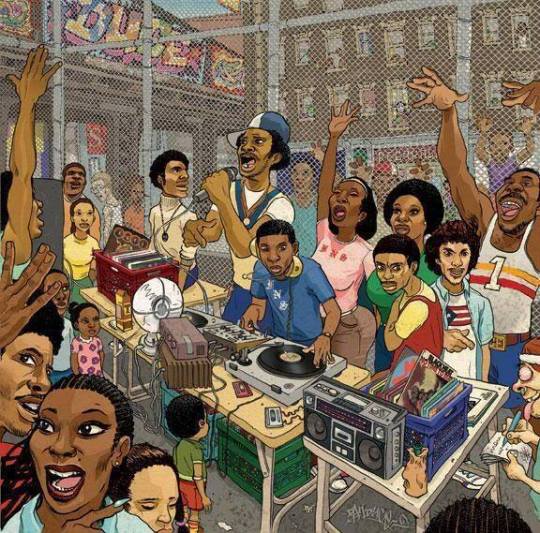
The hip hop culture has its roots in the Bronx, borough of New York, in the early 70s. At that time, no movement really existed. Many scattered performances were developing in the streets of the Bronx with no global leader.
DJ Kool Herc, Jamaican–American disk jockey, started organizing dance parties at his home. His parties soon spread throughout the Bronx. Quickly attracting a lot of young people, Kool Kerc made a name in the district, organizing more and more parties, indoor and outdoor, always in the Bronx. DJ Disco Wiz and Casanova Fly, Herc’s henchmen, were hacking the electric power of the street lights in order to party in the basket fields of the Bronx.

This is the flyer of the Back to School Jam that took place August 11, 1973 at Kool Herc’s place. 1520 Sedgwick Avenue is an apartment building that was recognized on July 2007 as the birthplace of Hip-Hop. This is where the first parties organized by Kool Herc took place. It has been honored in June 2017 with an award. The moderate rent building is now standing on the newly inaugurated Hip Hop Boulevard, marking where it all began.
youtube
1- The Deejaying
Kool Herc created a new music with 2 turntables playing Disco music, hard Funk and other James Brown records combined together. By playing the drum beats of the songs alternately, he enhanced “the break”. This is the birth of Hip Hop Music. Without delay, a lot of young artists started Deejaying and creating new techniques around this new culture.
In these new artists, Theodore Livingston. In 1975, he is only twelve, practicing turntabling in his bedroom when his mother yells at him from another room. The young artist, now known as Grand Wizzard Theodore, puts his hand on the spinning record to stop the music and causes the “shigi” sound. So the invention of the scratching technique was an accident !
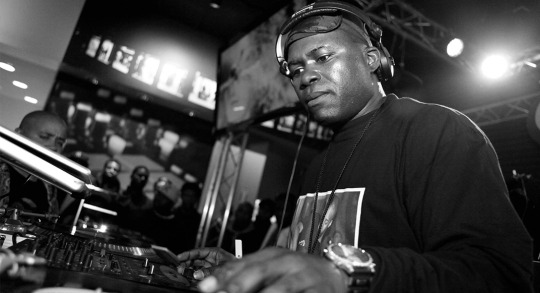
If the origin of the name Hip Hop is often disputed, some say that Keef Cowboy, member of the groupe Grandmaster Flash and the Furious Five, teased a military-friend by faux-marching to the sound hip-hop-hip-hop. Or the name might come from Afrika Bambaataa, African-American DJ who largely influenced the creation of the Hip Hop movement. At that time, the gangs made the law in the Bronx. Violence and brutality were at every corner. Lance Taylor (Afrika Bambaataa), who used to be a member of the gang P.O.W.E.R and the leader of the Black Spades, started an Anti-Violence Movement (now known as the Zulu Nation). He soon understood that using the new performances of the youth would help canalize their energy. So, inspired by DJ Kool Herc, he started hosting parties in the city. Turntabling, organizing dance contests, inviting MCs to animate the show, welcoming graffiti writers…
The four main pillars of hip hop appeared.
2- The Breakdancing

While DJs like Grandmaster Flash and Afrika Bambaataa began building music on Kool Kerc’s innovations, the breakdown inspires bboys and bgirls. Breakdance is a street dance largely based on drums and funk music. This dance holds a major part in the urban culture and is full of athletic moves. This discipline also thrived in the 70s with bboys like Trixie or Dancing Doug. If he was already dancing before DJ parties were organized in the Bronx, Lauree Myers, better known as Trixie affirms :
“When we did go to Herc's parties that's when I took it to another level.”
youtube
3- The Spraywriting
Third element composing Hip Hop, the Graffiti, or Spraywriting. It is a form of artistic expression that primarily involves illegally painting walls in the streets and trains in the city. There are many different types and styles of Graffitis, ranging from words to drawings. This activity is the most controversial of Hip Hop elements. Widely considered as vandalists, the graffiti artists need to draw fast and run fast. Generally ran in public places, this business often involves running from the police, especially when a huge part of the graffitis were spelling “A.C.A.B” (All Cops Are Bastards).
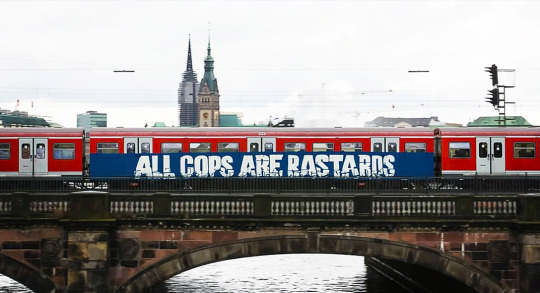
Graffiti already exists for a long time, the first “graffitos” dating from the ancient Egypt or Roman Empire. But the Graffiti we are talking about here doesn’t originate from New York but from Philadelphia. In the 1960s, the first known graffiti writers Cornbread and Cool Earl used black markers to tag their nicknames on all public property throughout the city. In 1968, the rail transport between Philadelphia and New York intensifies. The wagons are moving frames, exposing the paintings from one city to the other. A train to success. In 1970, Topcat 126 copies their practices and brings graffiti tagging into the big apple.
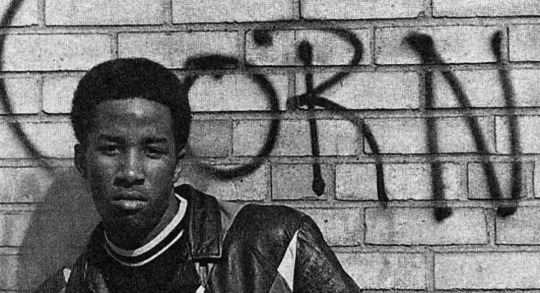
At this time, a bunch of buildings are popping up every week in the city. The youth wants to take over on these new walls and spaces. In the 70s, many issues of racial and social inequality were already taking place. The non white youth adopts this art as an expressive form of rebellion. One of the street art pioneers, Quik, explains to Widewalls :
“Graffiti was intended as a “voice” to be heard; as we sought a broader audience than our immediate community.”

In the first generation of graffiti artists, we can also cite Futura 2000 or Phase 2 who also largely influenced the discipline for decades. Everyone invents new styles, trying to make their tags more unique and noticeable. LEE 163 joins his letters together. Later comes the Stencil Graffiti with Blek le Rat in Paris. Groups such as United Graffiti Artists and the Fabulous Five start working together to make more elaborated canvas and to escape the scenes more discreetly.
This was all before graffiti became fashionable. At that time, graffiti artists were chased by the authorities. Only ten years later, a painting of Jean-Michel Basquiat, who started as a graffiti artist, was sold for over $110 Million.

4- The MCing
Last but not least, the rapping. If MCs (Masters of Ceremony) were originally at parties to animate the show and cheer the dancers, they were also here to communicate. To talk about the problems faced by the african-american community. Dancing and spraywriting were a great way to express the feelings, but rapping had no equal. Rap has its name from the slang word meaning “conversation”. Or maybe it stands for Rhythm And Poetry. Certainly both.
The 3 major components of MCing are the content, the flow and the cadence. The three are essential to deliver a message and get the listener to feel your melody and bounce their head. Rapping is the rhythmic spoken delivery of rhymes and wordplay usually over a beat. Rapping has its roots in Africa. Centuries before Hip Hop music existed, the griots (traditional communicator) of West Africa were delivering stories rhythmically, over drums.

At his beginnings, Grandmaster Flash was so focussed on his mix, breaks and scratching skills that he forgot one of the essentials. The mic. The occasion for some to propose their services. One day, Flash met Cowboy, an MC as charismatic as his word.
His entry on Flash’s scene inspired two brothers : Melle Mel and Kid Creole. Creole was really good at freestyling, but little was Mel who decided to work his texts before the shows. Quickly, his sharp feather offset his ad lib skills. He becomes the leader of Flash’s new vocal trio and inspires others to work on their texts, ad style figures and play with words.
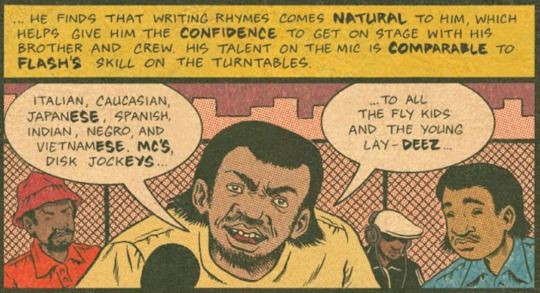
The Last Poets were the first group to throw an album out in 1970. It coupled spare funk and aggressive delivery, combined with socially-conscious word. This is the basis of MCing. Social and racial awareness are the foundation to the vocal performance in Hip Hop.
It is hard to cover this whole rap period without talking about Kool G Rap, the Godfather of Gangster Rap, the Sugarhill Gang, first group to ever throw a rap album, the Treacherous Three, MC Hammer, the Funky 4+1, the Cold Crush Brothers…
youtube
Widely inspired by jazz, soul, funk and disco, the Hip Hop movement is multicolor. Created and lead by african-americans, it has a root in Africa, one in Latin America, one in Asia, another one in Europa… Hip Hop is a multicolor culture that assembles the people.
According to Kurtis Blow, an MC from the outset who started as a Master of Ceremony for Flash’s parties :
“I'm a firm believer that hip hop and rap is so malleable; you can shape it in any form. We have these fusions like rock n roll rap, reggae rap, country and western rap”
This is how Hip Hop, now a truly international cultural movement, had its start.
PEACE, UNITY, LOVE AND HAVING FUN
#hiphop#hiphop history#hiphopbeenybop#today in history#today in music history#music#rap#dj#graffiti#breakdance#Birth Of Hip Hop
22 notes
·
View notes
Text
Ancient Civilizations: Sound as a free energy
Recent archaeological findings suggest that the Sumerian may have inherited from an earlier civilization that emerged may thousands of years earlier in Southern Africa, the cradle of human kind.
Extended scientific evaluation over a two years period has shown that the circular structures are in fact energy generating devices using the natural sound harmonics emanating from the surface of the earth.
Adam’s Calendar is the flagship among this ruins because we can date this monolithic calendar with relative certainty to a time before the flood event, some 13.000 year ago, and at least 160.000 year of age based on a number off scientific evaluations.
Forms Arrangement to Generate a Frequency:

The shapes of these circular ruins are all very specific and unique because each circle represent the cymatic shapes of the sound energy as it appears on the surface of planet earth at that point.
This energy was amplified by simple understanding of harmonics and utilized in the same way that we generate a laser and laser beams technology today.
We have measured these energies and electromagnetic waves in spectacular fashion and therefore we do not hesitate to make this claims.
Cymatic Shapes of the Sound Energy:

Some of the sound frequency is going in the extremely gigahertz levels, over 380 GHz, which are unheard on earth today in any normal application.
The fact that this circles are all connected by the tone channels makes it very clear to any scientist who works with electricity and energy that this vanished civilization had a keen understanding of energy that still escapes us today.
Southern Africa was a giant energy grid that was all connected for the purpose of mining gold and all other activity necessary for supporting the vast population that lasted for over 270.000 years until it was wiped out by the flood some 12.000 years ago.
The manipulation of the human race has continued for over 250.000 years by exposing the origin of the royal bloodlines and how they continued to manipulate human activity today mainly by controlling the supply of energy and the control of money.
Adam’s Calendar – Southern Africa :

The Adam’s Calendar, also called the Enki Calendar, is the oldest menhir system in the world.
Similar to the most famous Stonehenge, but older than many thousands of years, it is located near Mpumalanga (the place where the Sun rises in the Zulu language).
The reason why this structure was called a calendar is due to the fact that it is arranged to follow the evolution of the sun throughout the year.
But the most interesting discovery is the relation between the arrangement of the megaliths, the ground below and the sound frequencies found in the stones.
Michael Tellinger explains that:
“These stones do not have doors or entrances, and the extraordinary amount of sound energy and electromagnetic fields they produce, it goes beyond the imagination.
To achieve all this, we need energy generators that use the knowledge of the laws of nature and of dynamics, of resonance and frequency. We are dealing with an ancient technology that we just begin to understand.”
Circular Structures as Energy Generating Devices :

136 notes
·
View notes
Note
1-10 for an oc of yr choice (since i don't know any of yrs (yet))
meme here
I’ll use my FFXIV OCs bc I’m finicky abt sharing anything on my manuscript OCs in public
Vaste/U’ralhana Odh:
1. What is/are your OC’s nickname(s) and how did it come about?
Her name situation is a little messy but theres a reason behind each one both canon and non-canon! The game by default gives the WoL many titles across the game to reflect your progress to NPCs like eikon-slayer, Azure Dragoon, khagan etc. all tied to feats or positions earned in the MSQ.
For non canon titles and nicknames I’ve given her Desert Dragon due to her origin of birth from a desert tribe and their guardian animal being Drakes (as well as the fact that she’s a Dragoon and DRGs are traditionally a class associated heavy with dragons), Nine Lives because of the Echo preventing her from true death which also fits with her being a cat race etc. For more personal nicknames one of her younger brothers calls her Rala after her Sun Seeker name being U’ralhana Odh, dearest is also the most common pet name Yugiri has for her, aside from having the privilege of calling her only by her first name for her Sun Seeker side
Her formal naming convention gives her three viable names,
U’ralhana Odh - name the Sun Seekers gave her when she was born to them, the U designates tribe affiliation, followed by her given name, the surname is her father’s first name indicating he sired her (official FFXIV Sun Seeker naming convention) together the name means Ralhana of the Drakes, daughter of Odh
Osha Tayuun - this is the name her mother gave her before she left to rejoin the Moon Keepers in The Black Shroud, she never learned it was hers until the day they finally met well into her adulthood as the WoL, because Moon Keepers are matriarchal unlike Sun Seekers, the last name is also her mother’s while the given name is a normal girls name (i also made it start with O and try to sound similar to her mother’s first name, Oghii)
Vaste Valescoere - she gave herself this name after once being taught a few ancient Garlean (irl Classical Roman Latin) words by a traveling scholar from what little outside contact the tribe saw, once she made the decision to leave to be an adventurer forever she was banished for forsaking tradition, thus she felt she died and needed a new name - this was the first name i gave her because when i first started playing FFXIV i didnt know the races had naming conventions so i just wanted something that sounded like a fantasy name ( i literally just looked two words up in my latin-english dictionary fddjfd)
2. What is the color of your OC’s eyes/hair/skin?
Blue hair with natural black highlights, green eyes, light skin but not pale- all generally Moon Keeper traits but when i was starting out i knew none of that and did what i wanted, her bizarre appearance once i decided she was from the U tribe influenced her being half Sun Seeker and Moon Keeper
3. How tall is your OC?
5′2 but only because i thought the CC slider meant 5′6 (cuz it lists height in inches and i didnt bother to check ujhghugj shes sometimes embarrassed by her height especially standing next to much taller people, shes still taller than Yugiri though so she enjoys the slight height advantage
4. What is a noticeable physical attribute of your OC?
Her hair, then her eyes
5. What does your OC normally wear? What would your OC wear on a special night?
She’s usually in her armor with her current spear glamoured to appear weaker than it actually is because the simple style reminds her of what she used as a teen before leaving home:
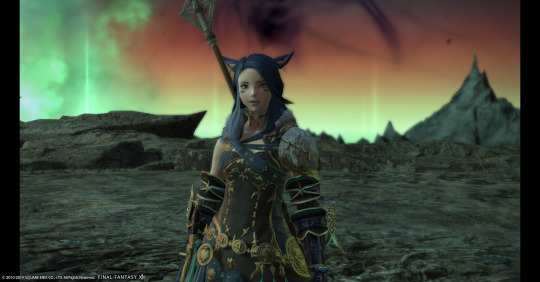
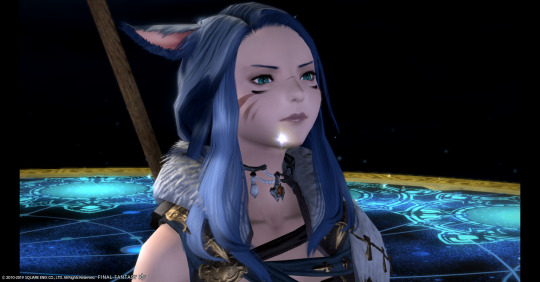
^^ necklace and earrings are different but the second necklace is more typical

im weak for the one arm/shoulder armored while the other isnt or not as much aesthetic
For more special/formal occasions w/o armor she likes wearing this:
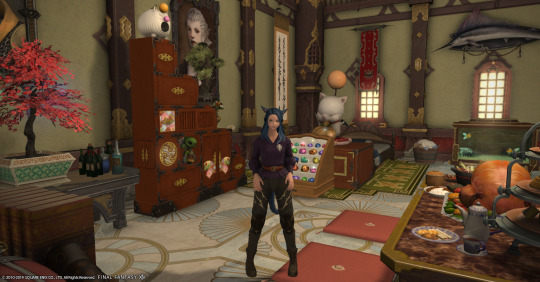

6. What is one word you would use to describe your OC’s appearances?
Every time she shows up there’s something dramatic (but not always over the top) happening
7. Does your OC have any markings, such as a birthmark or a scar?
She has the usual pinkish red stripes on her cheeks all Sun Seeker women are born with, in addition to a scar across her nose bridge she got during her huntress rite of passage when a sundrake struck her face (this rite is also how she got the black marks under her eyes afterwards, originally i just liked how they looked and made a backstory for them because the game lists them as tribal tattoos in CC)
The scar i gave her in CC as a ref to Guts from Berserk cuz his is similar (she obtained hers very young like he did as well):

8. How does your OC talk/what does your OC’s voice sound like?
i chose the CC voice 2 option for female miqo’te (you can kinda hear what it sounds like here and here @2:10 since i cant find a video with just vc2 range) and im happy with it (to me it kinda sounds like Rie Tanaka? as far as i know the CC voice VAs have never been revealed so i cant say for certain, i know shes done voicing for FFXIV as Kan E Senna and Sadu and plays it as a huge fan tho) as far as how she talks all Miqo’te are said to have their own racial language unique to them that no other race can accurately pronounce or understand due to all the hissing, purring, and spitting of certain sounds (bc theyre cat ppl lol) so she’ll roll/purr her Rs, hiss her Hs etc.
On top of this system i imagine the U have their own dialect accent too which i hc sounds closer to Xhosa and Zulu mixed if a cat tried to speak it,so it gets complex! Her native accent however becomes slightly toned down the longer she spends away from the U as the WoL, but its still present and obvious enough
9. What does your OC’s bedroom look like? His/her living area?

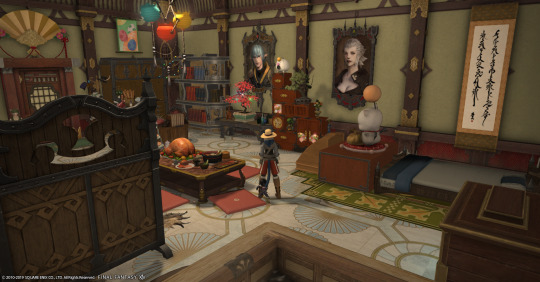
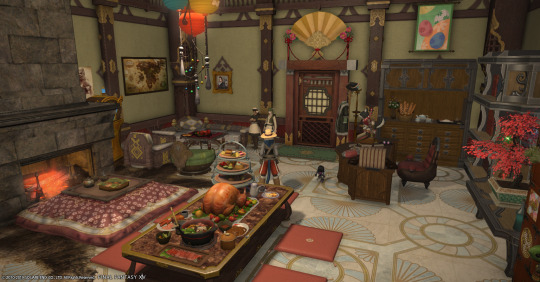

the only description valid for this is an organized mess lmao
10. What does your OC keep in a special drawer?
anything small enough to fit given to her by people from her past or those she cares about that linger on her mind, shes somewhat sentimental sometimes
—-
Gan Arulaq
1. Lizard boi has no nicknames that stick outside of being called Bataar playfully by his parents esp his mother bc he liked playing pretend as a heroic figure when he was little (i was aware when i made him in CC that Xaela use Mongolian names and are based a lot on Mongol culture of the 14th century so he follows this convention)
His first name is Mongolian for Steel, his last name denotes his tribe following the game’s convention, simple
2. he is a tan/reddish brown color for skin with black hair and natural red highlights in a short swept back style (his eyes are also green bc i wanted to see what Vaste’s eye color would look like on a Xaela model, tdlr they glow!)

3. Gan is 7′1! the tallest of my characters period, he sees everything from up there and it creates some hilarious and awkward situations (poor guy and most doors, rip)
4. his eyes and his big curved horns
5. he loves wearing primarily clothes that expose a lot of his chest and skin in general because thats most natural to what he wore on the steppe valley back home (as well as being a little vain about his physical appearance and liking the feel of freedom in less clothes) however he can and will wear regular clothes, though in this case his fashion sense is terrible
6. when he appears you can associate him with change (succession is another word that comes to mind given his role to Vaste)
7. with the exception of minor scars from martial training and small accidents he’s the picture of normal for a Xaela
8. i actually cant remember what CC voice i gave him by number, but he does have a somewhat deep, rough voice fitting for a boisterous young man while also being capable of sentimentality and some wisdom, he has a handsome voice, he speaks bluntly but full of feeling and often truth
9. his room would be very organized and everything is neatly assigned to its place as well as being primarily spartan in layout/decoration, he’s used to practicality and function from his childhood on the steppe, lots of trinkets from nature, weapons and trophies of victory etc.
10. a ring given to him by his mother carved from sheep bone, it was her archery thumb ring
5 notes
·
View notes
Text
AFRICAN ATTIRE FOR LADIES
Africa is a mixture of various cultures; ethnic teams and religions have given rise to a range of ancient dresses. In African cultures, for instance, age and social standing are mirrored within the garments individual wear. Here, we tend to take a view of the assorted styles of ancient wear found on the continent. Attire is a type of outfit that ladies wear in Africa, but it’s also wear as fashion garment all over the world. It is includes numerous nations belonging to a diverse group of people having not similar as well as similar demographics.
Attire for Ladies:
African Attire for ladies is an outfit with a massive flare and printed designs. There are most of the models introduced by designers by keeping an eye on the African culture. Attire is most common in Fashion all over the world. Different type of detailing is done to make it look more stylish and modern.
Traditional African Clothing:
Traditional Clothing of African ladies is one among the foremost inventive varieties of expression and one wherever South Africans like to show their various culture.
Zulu Attire:
Ancient Zulu codification is an animal product for men and skirts adorned with hardwood beads for ladies. The Indian ethnic garments are loincloth, kurta, and trousers tunic, sari, turban and sherwani for men. Zulu Attire is typical in Africa and India.
Xhosa Attire:
Xhosa dress includes elaborately stitched styles on blankets that are worn by each man and girls as shawls or capes. The reverse image that explains the Nguni tradition is face-painting by girls. For the Nguni individuals, face painting allegedly improves the beauty, and if truth be told, no old apparel is complete while not it. The dots and pictures often found on the face, arms and legs, reckoning on the design of the dress that's worn.
Tswana Attire:
The Tswana dress in ancient animal skins, communicate themes of nature and imitate animals through dance, applause and song. The ladies clap and sing to assist the dancers in reaching a trance and shortly the dance becomes frenzied. The African individuals wear swashes that are vibrant German-print garments, and therefore the men wear blankets.
Modern African Attire:
In today's age, the theme of Fashion and living has been changed and turned into another way. Now Individuals pay more attention to their clothing than anything else. Clothing and wearing got much focus on people now than before. The idea of wearing Attire as well as suiting is considered much. Appearance is much more critical now. Keeping an eye on this modern age's requirement, designers have introduced stylish Attire for ladies with a slight amendment in the traditional ones. Few are some designs used to turn conventional attires into Modern ones.
Embroidered Attires:
Now modern attires are decorated from the front as well as from the back. This embroidery gives a new look to the traditional attires. The colour embroidery puts a unique feel and touch to the style of Attire.
Find more details at: - African attire for ladies
1 note
·
View note
Text
Research: History of Black hair
Many of the hairstyles that are popularized within the black community have origins to many different times in history.
Ancient Origins
Many traditional hairstyles can be traced back to Ancient Egyptian times, this is evidence is often found in drawings, engravings and hieroglyphs from the time. These detailed drawings often have imagery of box braids, dreadlocks and afro styled shape-ups.
A famous painted sandstone piece that depicts the Egyptian Queen Nefertiti was re-discovered in 1913 showcases her getting her hair braided, this imagery embodies feminine power. During this times wigs were a symbol of wealth and royalty for men and women, only those of wealth were approve of wearing such thing as wigs.
The first image depicts the princess having her hair done (2050BC sarcophagus of princess Kawit)

However there has been evidence of Braids being traced back to the Ancient Nok civilisation in Nigera. There is a sculpture that dates back to 500BC that shows a figure with cornrows.

Braids
Braids throughout history, especially African, were a symbol of wealth, religion, martial status, age and rank within west African communities. The skills of braiding is seen as a art form that in many African communities is passed down from the elders to the daughters of this community, this is also now seen in the western community as myself i learned how to braid my hair from my mother and sister. Bandtu knots which are still popular to this day is a well known hairstyle within the African communities, bandtu translating to “people” in many African languages aswell as also being known as Zulu Knots by the Zulu people.
Cornrows
Cornrow braids were named after there similarities to cornfields. Africans originally wore these braids as a representation of agriculture, a tribe that is known for this style of braids is Mbalantu women in Namibia who were known for wearing what they called eembuvi braids.
During colonisation many africans had their heads shaved to strip them further away from their identity, so when they could grow their hair out they often braided their hair into cornrows because it was more manageable under the harsh condition they had to work in and it was away to stay connected to their roots which was being taken from them. Aswell as the fact that the more looser the curl or straight their hair was the better they were treated by the slave owners, ie they got to work inside the house rather then in the field.
During this time aswell slaves would often use the partings within the braids to relay messages, it became a way for slaves to communicate maps. “people would use braids as a map to freedom”. They often used to amount of braids to indicate how many roads.

Straightening hair
After slavery abolished there was still a need to fit into European society in which said that European straight hair was “good” and acceptable, whereas African hair was “bad” foreign and unprofessional. These standards still apply loosely to today especially against black women within office situations and high professions.
This meant that many Black people turned to wigs and chemical treatments to achieve this smoother straighter hair. Cornrows and braids were no longer seen as acceptable in public display. In the early 1900s Annie Malone and Madam CJ Walker developed products that target this want and need for straight hair. These products promoted the use of hot combs and products alike.

Dreadlocks
In 1920 Jamaican born Marcus Garvey started a black nationalist movement in America. He spreaded the belief that all black people should return to their rightful homeland of Africa. This also showcased to the masses the hairstyle of dreadlocks. Many people associate relate this hairstyle to the Rastafarian religion. Early followers of the religion refused to cut their hair due to the Nazaire vow in the bible. In the 1950s many followers didn't want to cut or manipulate their hair as they saw it as a sign of conformity.

Natural hair movement
The natural hair movement was brought on by the civil rights movement of the 1960-70s. This movement encouraged black people to accepted their natural hair and texture, start to turn away from damaging products that are used to conform to European standards. Wearing these natural hairstyles proudly were a form of activism, a way to show that they are reclaiming their roots. Popular icons known for there natural hair were, Diana Ross, Angela Davis and Jimi Hendrix. These celebrities who celebrated and embraced their natural hair were still unsurprisingly met with backlash from the public.
Other styles that were popular were Jheri Curl. This was a chemical treatment, similar to relaxers, that soften the curl of the natural hair. This style was one of the more popular hairstyle that many black people wore in the 80s and 70s popularised by musicians such as Michael Jackson and Ice Cube. During the 80s it made it easier for the public to accept this kind of curl.
80s music and hip hop influenced the culture and fashion, this lead to barber shops becoming more creative and expressive. Afro’s began to be faded at the side, this became the high-top fade. Traditional braids were added in for a flair of individuality. Celebrities such as Grace Jones and Will Smith made this popular.

Cultural Reaction
These changes brought on by the civil rights movement were meet with resistance.
In the 1980s Hyatt Hotel chain fired black female employees who wore cornrows. 1990s FedEx couriers were fired if they had dreadlocks. Black children are often told to this day that their natural hair was a violation or a distraction in the classroom ending in them getting expelled.
These reactions are the sort of thing that makes it hard for black people to want to embrace their natural hair.
5 notes
·
View notes
Text
[PDF EPuB AudioBook Ebook] African Textiles Color and Creativity Across a Continent EPUB PDF
[PDF,EPuB,AudioBook,Ebook] African Textiles: Color and Creativity Across a Continent EPUB / PDF
African Textiles: Color and Creativity Across a Continent

[PDF] Download African Textiles: Color and Creativity Across a Continent Ebook | READ ONLINEhttp://read.ebookcollection.space/?book=0500292213
Author : John Gillow Publisher : ThamesHudson ISBN : 0500292213 Publication Date : 2016-2-15 Language : Pages : 240
To Download or Read this book, click link below:
http://read.ebookcollection.space/?book=0500292213
Full Pages
Synopsis : [PDF,EPuB,AudioBook,Ebook] African Textiles: Color and Creativity Across a Continent EPUB / PDF
The traditional, handcrafted textiles of Africa are sumptuous, intricate, and steeped in cultural significance. Region by region, African Textiles covers, as no other volume has, the handmade textiles of West, North, East, Central, and Southern Africa, outlining the range of weaving techniques, and the different types of looms, materials, and dyes that create these sumptuous works. Nor does it neglect the cultural context of African textiles, assessing the various influences of religion, culture, trade, tradition, fashion, and the changing role of women that inform their creation.The breathtaking skill and creativity of the African peoples are presented here in radiant color—the gorgeous stripweaves of the Ashanti and the Ewe; the lace weaves of the Yoruba and the bogolanfini mud cloths from Mali and West Africa; the Berber weaves from Algeria, Morocco, and Tunisia in North Africa; the unique, crocheted, embroidered, and feathered hats from Cameroon; the ancient weaving tradition of Ethiopia; the beadwork of the Zulu, Xhosa, and Ndebele peoples of Southern Africa; and the Asian-derived tradition of weaving silk and raphia in Madagascar.A guide to African textile collections open to the public, a glossary, and suggestions for further reading make this volume a practical as well as beautiful guide to the rich art of African textiles.
0 notes
Text
IN SEARCH OF MATISSE'S MOROCCO
Henri Matisse saw Tangier as an earthly paradise. The artist visited the city twice, in 1912 and 1913, in search of a new direction for his art, and found inspiration for his greatest works in the bright African light, vivid colors and languid sensuality of the Moroccan landscape and architecture, the gardens and the people.
So when I visited Morocco's fabled city on the northern rim of Africa last year, I decided to follow in the footsteps -- or rather, the brush strokes -- of Matisse. What better guide than the great artist himself? I would try to see Tangier through his eyes.
An added inducement was the upcoming exhibition -- "Matisse in Morocco" -- of paintings and newly discovered drawings executed by the artist in Tangier, which opens next Sunday at the National Gallery of Art and runs through June 3 before traveling to the Museum of Modern Art in New York. More than half the paintings are on loan from the Pushkin and Hermitage museums in the Soviet Union; some have never before been seen outside that country.
The exhibition comprises the largest group of Matisse's Moroccan works ever to be shown. That alone seemed reason enough to look for Matisse's Tangier.
Matisse did most of his paintings in Tangier's casbah, or fortress, and in the medina, or medieval walled city. "He found what he wanted there," said Jack Cowart, curator of 20th-century art at the National Gallery. "Besides, Matisse really didn't like to travel farther than about a 400-yard radius from his hotel. He always had so much baggage to move about: canvases, stretchers, paints."
Often Matisse simply stayed in his hotel room to paint. When he first arrived in Tangier in January 1912, bad weather kept him inside. He sent a grumpy postcard to Gertrude Stein informing her that for five days "it had rained incessantly." So he set a vase on his hotel dresser and painted "Vase of Irises." That work anticipated the many hotel interiors he later painted in Nice, France.
But it was the view painted from his hotel in his famous "Landscape Viewed From a Window" that I wanted most to see.
During both of his several-month visits to Tangier, Matisse stayed at the Grand Hotel Villa de France. I made my way across the Grand Socco, the bazaar area, and up the hill above the medina, through crowded streets lined with small, open-fronted shops to the old hotel. It sits apart on a promontory high above the modern center of town with its wide boulevards and smart shops.
"Guests book their rooms here a year in advance," the desk clerk told me. And the frayed luxury of the hotel's portrait-lined lounges, blue-tiled courtyards, fountains, swimming pool, long terraces and gardens thick with pink hibiscus, white trumpet flowers and spiky green cactus coiling up the dark trunks of palm trees all seemed wildly romantic to me. No wonder Matisse stayed here!
In lofty comfort he looked down on the bright white city with its deep blue bay. I had to see his room!
But No. 35 was taken, I was told, by an artist from Japan who had reserved it for one month.
"Then I'm sure she won't mind if I knock on her door," I said. A most reluctant clerk led the way.
Maria Takakuwa smiled at my request and bowed me into the rather small, simple room. It was sparsely furnished in a hard, square, 1930s style -- certainly not the decor of Matisse's time. But the same tall shutters stood open, and palettes, brushes and tubes of oil paint littered the room and covered the bed.
She motioned me into the large old-fashioned bathroom. There, on two straight-backed chairs, Takakuwa had propped the big canvas she was working on. "This," she said, pointing out the bathroom window, "was Matisse's view." Together we leaned on the sill and looked out.
Below we saw what Matisse had painted in the "Landscape Viewed From a Window": the green-tiled roofs and square white steeple of St. Andrew's English church, now nearly hidden by date palms and evergreens; the white city; the tall, square, tiled minaret; the casbah on the distant hill and the sapphire Mediterranean Sea beyond. It was a magic moment.
Later, a small boy led me through a maze of alleyways in the medina, up a narrow, steep street of shallow steps to the casbah. We entered through Bab el Assa, or lookout gate. Here Matisse had set up his easel to paint the distant view of Tangier. He used the gate as a frame, foreshortening, rearranging and adding elements to suit his composition until all that remained the same as the actual setting was the shape of the gate and the distinctively Moroccan mood in his magnificent painting, "Casbah Gate."
Next to the Bab el Assa is the wall fountain, dry now, whose brightly colored patterned tiles, which appear so often in Matisse's paintings, are still in place.
In the casbah is the Dar el Makhzen, a former royal palace, now a museum, where Matisse presumably studied the beautiful tile work, wandered in the garden and absorbed the Islamic atmosphere. It was a new, exotic world. Its impact, according to Cowart, was "the hinge" between Matisse's earlier European fauvist style and his more original, powerful later work.
The "Moroccan Cafe"that Matisse painted has changed, however. Although men still are the predominant cafe patrons in this orthodox Moslem country, only a few continue to wear turbans or red fezzes with long black tassels. Yet most Moroccan women remain veiled, dressed in drab gray or black, their mouths covered with white cloths. Matisse probably found his colorfully dressed models, both male and female, in the souks or markets, where today Riffian tribesmen stride through the crowded lanes in striped djellabas, and Berber tribal women in wide-brimmed, conical straw hats topped with pompoms carry their babies on their backs.
Matisse painted his "Acanthus," "Periwinkles (Moroccan Garden)" and "The Palm" in the garden of a private villa owned by an Englishman. Then as now, life went on behind high walls.
For the outsider, wandering through Tangier's streets of flat facades is like being in the desert, looking at blank walls that one knows enclose lush oases. Hidden by monochrome exteriors are richly decorated interiors. Plain outside, patterned inside.
Hotels attempt to create the atmosphere of Arab palaces with thick carpets, mirrored walls, brass pots and tiled courtyards. Their rooms are large and public, however, conveying none of the intimate secretiveness of Arab architecture.
But there is a rambling, 30-room palace in the medina where visitors can get a true sense of the typical Arab palace. The Tangier American Legation building, given to the United States by the sultan of Morocco 169 years ago, is the oldest diplomatic property of the United States to be continuously owned, and is open to the public.
I rounded the corner of Rue d'Amerique in the old Jewish Quarter and saw above me, on the building spanning the narrow street, the Great Seal of the United States and a massive, wooden, nail-studded double door with another Great Seal. I pushed the bell and, stepping over the threshold, found myself in a little courtyard, complete with fountain.
The museum is a honeycomb of rooms great and small: reception rooms, secret rooms, courtyards and a Moroccan pavilion, adorned with curved marble staircases, massive fireplaces, Portuguese grillwork and carved wooden ceilings. But there is more than architecture to delight the senses. Besides many historic documents, there are fine 18th-, 19th- and 20th-century engravings, drawings and paintings. I admired a huge oil painting of a sultan with his splendid horse, a portrait of Maxwell Blake (who served as American consul general in Tangier in the early 1900s) and fascinating old photographs of the legation reception rooms when they were in diplomatic use.
I was fascinated with the works of John McBey, a Scot who lived in Tangier from the 1930s through the 1950s and who executed many etchings and watercolors of Moroccan scenes. Expertly done, they are almost photographic in their realism. As the museum's director pointed out, it is only in the context of such works that one can fully appreciate the stunning originality of Matisse's paintings.
Outside the museum, I walked through the gate of the medina and up the hill toward St. Andrew's, the Anglican church whose roofs and steeple Matisse had painted.
The churchyard, with its pleasant, slightly overgrown cemetery, sits at the foot of the Grand Hotel Villa de France's promontory. There I found mostly English graves bearing such evocative inscriptions as "Lost at sea" or "In the Zulu wars." The church is an artful collaboration of Christian tradition and Arab architecture. The Moorish archway so loved by Matisse is the design of the chancel arch. Carved around it, in Arabic script, is the Lord's Prayer.
As I left the church and walked down the winding path hedged by huge hibiscus bushes, I noticed a small structure inside the churchyard wall near the gate. It was a cubbyhole, really, just large enough to accommodate the white-bearded, robed and turbaned man who reclined inside, writing on some papers in his lap. Another Moroccan, dressed in trousers and a sweater, sat cross-legged on the ground in front of the scribe. Altogether an incongruous sight in an Anglican churchyard. As the American composer and writer Paul Bowles once remarked: In Morocco, "everything that is not medieval is new."
It was a stunning reminder of the contrasting images that make up Tangier. Through Matisse's eyes I saw a fabulous city, filled with sharp contrasts of light and shadow accentuated by the luminous blues of sea and sky. But always there was a background cacophony of drums beating, roosters crowing, church bells ringing and the muezzins' calls to the faithful for prayers, to remind me that Tangier is an ancient city, a marvelous mixture of things medieval and modern, Moroccan and European, with much left to explore.
~ Luree Miller · Mar 11, 1990.
Luree Miller is a Washington writer whose most recent book is "Literary Villages of London" (Starrhill Press).
1 note
·
View note
Photo
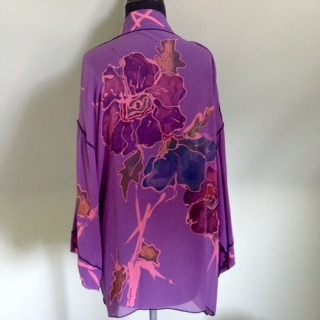


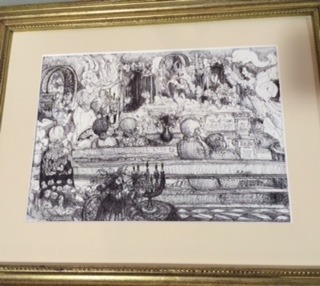
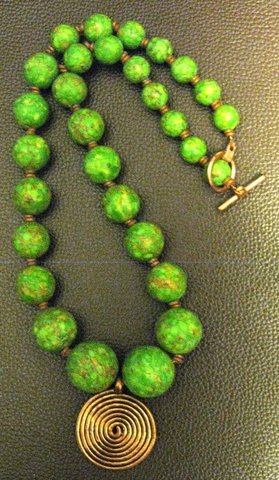



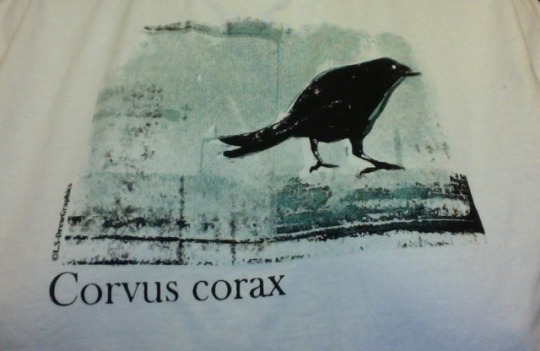
Kathy Robinson, Batik Wearables Designer — www.kathyrobinsonbatik.com
Kimono-Style Jacket, batik and hand painted silk, $320
“Often when asked to provide a written description of my work, it never fails to remind me of the fundamental preference for speaking through the work itself. I continue to find comfort in the simple tools and techniques of batik that I first encountered on the banks of the Delaware in the early Seventies. At first, now as then, I seem to see color and its emotional nuance in a piece; line and texture to follow.”
Kathy Robinson is a professional Batik artist and designer working out of her studio in Philadelphia, Pennsylvania. Relying heavily on the ancient wax resist method of Batik and using the Tjanting, the traditional Indonesian wood and metal tool, each piece is worked on as an individual canvas. The design of the garment, how it fits and flows on the body also play an important role in her “Wearable Art.” Recent studies in painting at The Pennsylvania Academy of the Fine Arts have influenced her use of color and also led to more “painterly” techniques on the silk. Her work has been carried by museum shops and galleries across the country, including The Michener Art Museum Shop, Woodmere Art Museum Shop, Brandywine River Museum Shop, Portfolio at Pennsylvania Academy of Fine Arts, Milwaukee Art Museum, and Museum of Jewish Heritage.
Gloria Rohlfs — [email protected]
Chakra Meditation, acrylic on canvas with lace, 16″ x 18″, $100
Rohlfs creates her art utilizing acrylics, fabric, photography and found objects. Her early work was influenced by quilting. Her art is inspired by her interest in the environment, peace, human rights and earth-based spirituality. Rohlfs’s work has been exhibited in group shows in upstate New York; New York City; and Philadelphia. Gloria Rohlfs has lived in Iowa; Munich, Germany; New York City and the Catskill Mountains.
Mia Rosenthal — [email protected]
iPhone (Scott), 4 ½ x 2 ¼ inches, ink, pencil and gouache on paper, $300
Mia Rosenthal will be having her first solo museum exhibition Mia Rosenthal: Paper Lens at the Pennsylvania Academy of the Fine Arts in the fall of 2015. She was awarded a 2014 Leonore Annenberg Fellowship Fund Grant for the Performing and Visual Arts and a 2015 fellowship at the Vermont Studio Center. Her drawings are included in the collections of the Philadelphia Museum of Art, the Pennsylvania Academy of the Fine Arts, Woodmere Art Museum, the Arkansas Arts Center, the Progressive Collection, Fidelity Investments and Wellington Management.
Rosenthal’s recent exhibitions include Keeping It Real: Recent Acquisitions of Narrative and Realist Art, Woodmere Art Museum, Philadelphia, PA, 12th National Drawing Invitational: Outside the Lines, Arkansas Arts Center, Little Rock, AR, A Little Bit Every Day at Gallery Joe, Philadelphia and Here and Now: Prints, Drawings and Photographs by 10 Philadelphia Artists at the Philadelphia Museum of Art.
Barbara Rosin, [email protected]
Minion of Peace, Ink Drawing, $125
Edward Sargent — [email protected]
The Angels of Our Better Nature Visit The Shenandoah, 28” x 14” x 4”, collage, $150
Age 74, graduated from Chestnut Hill Academy 1960, attended Tyler School of Fine Art 1960-63. Otherwise self taught. Exhibited at the Vis-à-vis Gallery in Philadelphia in 1963 and then at the Mt. Airy Art Garage 2013-14, but not during the intervening years.
Everything presents points of reference to me from the religious art of the Renaissance to the old Flash Gordon serials. I try to reach what I cannot reach.
Nettie Scott — [email protected]
Mosaic turquoise and spiral copper pendant necklace, $55
The crab agate and antique copper pendant necklace, $50
Nettie Scott, a retired social worker, spent thirty happy years in Alaska, working in the field of cross cultural mental health and addictions as well as teaching at the University of Alaska Anchorage. She has lived in many places around the globe, always fascinated by ethnic arts and crafts. An amateur potter when she moved to the Alaskan “bush” she found that the harsh environment was not friendly to pottery making. A few years later she discovered polymer clay and began making her own beads, as well as fashioning jewelry from ethnic findings, porcelain, pearls and semi-precious stone beads. Now she is exploring mixed media polymer clay work, creating mostly functional art and using polymer clay as a painting medium. She lives in Philadelphia with her husband, Dan Shanis, occasionally teaching the basics of working with polymer clay and jewelry making.
Laurel Schwass-Drew — http://lsdrewgraphics.etsy.com
Gift Certificate for a T-Shirt, $26
Laurel Schwass-Drew, aka L.S-Drew Graphics, is a Northwest Philadelphia-based printmaker who specializes in producing her own line of wearable textile imagery, mostly in the form of hand-pulled screenprints on T-shirts, and on hand-dyed scarves made of cotton or silk. Her wearables can be found in the personal collections of a growing number of loyal fans, both locally and across the world.
My line of hand-screen-printed T-shirts — hand-dyed & screenprinted silk, cotton scarves, all featuring my eclectic imagery for a touch of local artisan-produced little luxuries. Treat yourself or a friend!
Patricia Cousins Smith — [email protected]
South African Zulu Mother and Child Weaver, Photographic Print, $110
0 notes